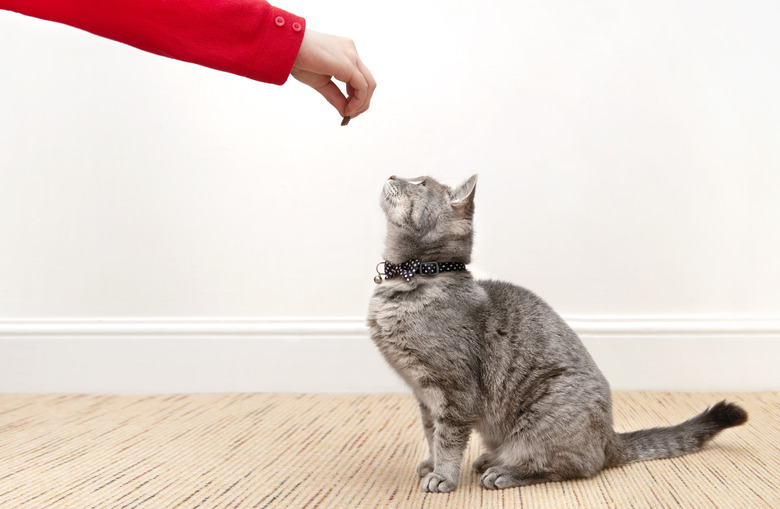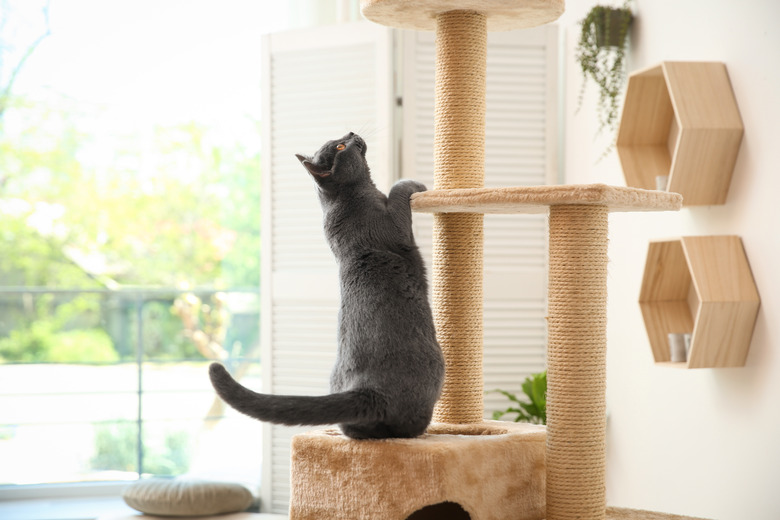Why Positive Reinforcement Training And Approaches Matter For Cats
When training your cat, you should always use positive reinforcement methods. This type of training can help you build a stronger relationship with your cat, even if you don't want to teach your cat tricks. Positive reinforcement training is also the fastest way to teach them new skills and avoid unwanted behavior. When training your cat, it's important to keep their training sessions rewarding and engaging.
What is positive reinforcement?
What is positive reinforcement?
Positive reinforcement training methods center on the idea that a cat's rewarded behaviors are more likely to be repeated in the future. The process relies on making sure your cat is connecting their desired behavior to the positive reinforcement they receive. You can use toys, games, treats, and food rewards when your cat performs the desired behaviors. Keep in mind, that the training isn't just about giving your cat treats randomly — proper timing is important.
Positive reinforcement training can be used for practical skills, such as crate training. It can also be used for behavioral modification, such as teaching your cat to stay off a kitchen counter. The main goal is to teach your cat the desired behaviors without the use of force or coercion. Positive reinforcement training also uses Fear Free approaches when handling cats, and these emphasize a cat's bodily autonomy.
Motivating a cat's behavior changes
Motivating a cat's behavior changes
When training your cat, it's important to make use of what is motivating them the most. Just like you expect to get paid money for a job well done, your cat also expects to get paid for responding to training cues. Each cat is different in terms of what is motivating for them. Most cats find treats or food to be the most rewarding.
A single ingredient, such as freeze-dried meat treats and lickable soft treats, can be very rewarding for cats. Others will find playing with certain toys to be motivating. It can be helpful to experiment with different kinds of rewards to see what is the most rewarding and to rank them from "low value" to "high value."
The "high value" rewards are ones you will want to use for teaching them new skills, and for reinforcing harder skills. The lower value rewards, which are things that your cat still likes and finds valuable, can be used for skill reinforcement, ones that are easier or more familiar for your cat. Again, rewards will differ from cat to cat.
Avoid aversives when training cats
Avoid aversives when training cats
It is important to avoid using aversives at all times when training and living with your cat. Any kind of cat training approach that uses startling, discomfort, fear, or pain must be avoided. An example of this type of training is positive punishment — and part of the operant conditioning learning quadrants.
Other aversives that are intended to startle and discourage behaviors a human dislikes include shaker cans filled with pennies, or squirt spray bottles. These aversives might stop a cat's behavior for a moment, but only because it is frightening and discomforting to them. This is not an appropriate way to work with cats. We don't want to frighten or cause pain and discomfort when training.
Using pain or discomfort doesn't teach your cat a different way to approach an unwanted behavior in the future. It's also important not to use negative reinforcement — another part of the operant conditioning learning quadrants. An example of this could be someone using physical force until a cat complies. An example is teaching a cat to sit on cue by pushing down their body until they sit. Instead, we always want to use positive reinforcement approaches — such as using a treat to lure a cat into a sit position.
Meet your cat's needs
Meet your cat's needs
Many of the "problem" behaviors that cat owners complain about are just a cat doing what comes naturally to them. Part of positive reinforcement training is understanding what your cat finds rewarding and their motivations. If you want to change a behavior your cat does, say jumping up onto the kitchen counter, it's important to understand first what your cat is getting out of this behavior.
Cats often jump up onto kitchen counters because they want foods they smell there. They also like often naturally like jumping on to high things. Many cats find height to be very valuable because it gives them a new vantage point and makes them feel safer. If you want to keep your cat off the counter, you'll want to give your cat another opportunity to get those same needs met. By providing your cat with a cat tree or cat shelves, you can provide those same needs as the countertop. Then, encourage your cat to be on the cat tree/shelves instead of the counter, by rewarding them with treats, food, and/or play.
Encourage your cat's good behavior
Encourage your cat's good behavior
When positive reinforcement training your cat, it is important to be proactive. Get ahead of the behavior you don't like by encouraging and rewarding your cat for the behaviors you do want. Cats are very smart, and behavior that has been reinforced in a positive way is more likely to happen again in the future.
For example, if your cat likes to jump onto the counter when you make dinner, give your cat treats over on their cat tree that will take some time for them to eat. Soft and lickable treats are especially good for this.
In summary
In summary
Positive reinforcement cat training is important because it is the fastest and most effective way to teach new skills and avoid unwanted behavior. These methods can also decrease conflict and improve your relationship by helping your cat understand what you want them to do instead. Cats appreciate opportunities to learn and by teaching them new things, your cat can develop new skills that challenge their brain. Positive reinforcement training will make both of your lives easier and more enjoyable.


